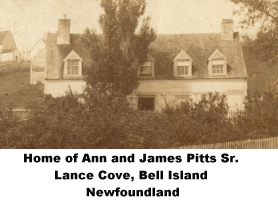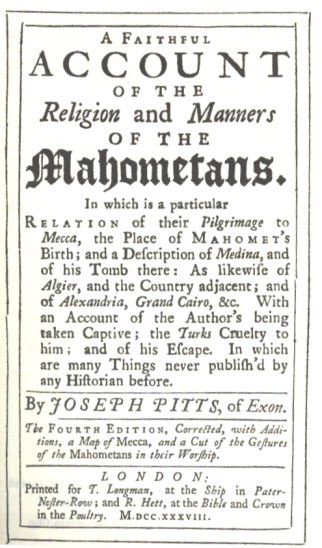
| . |
HomePort  |
|
Pitts@HomePort
|
| . |
 |
HomePort is
pleased
to host materials related to the descendants of Ann and
James Pitts Sr. of Lance Cove, Bell
Island, Newfoundland. James Sr. was born in 1735 in
Kennford near Exeter, England arriving as a teenager in
Newfoundland by 1751. The
couple had three sons - John (1783-1825) married Elizabeth
Picco (1786-1826), James Jr. (1784-1870) married her
sister, Frances Bartlett Picco (1786-1864), and William
(1787-1869) married Ann Juer (1794-1869). John Pitts drowned in Conception Bay in 1825, and his wife Elizabeth died the next year. Their surviving children, lived with their double cousins (Aunt Frances & Uncle James Pitts Jr.) and all relocated to St. John's, Newfoundland where the children grew up in a large combined family. Capt. William Pitts and his family remained on Bell Island. |
Descendants include
individuals whose careers are recorded in the Newfoundland
Encyclopedia:
Three Pitts descendants Gerald Ayre,
Eric Stanley Ayre
and Bernard Pitts Ayre, were members of the
Newfoundland Regiment and died at Beaumont-Hamel on July 1,
1916. Ethel G. Dickenson
(1860-1918) a descendant, is remembered for her wartime
nursing career, and her selfless concern for others that led
to her own death from the Spanish Flu.
"His [E.J.Pratt's] roots go much deeper. . . for through his mother's family he can trace back to a generation of Newfoundlanders, Joseph Pitts, who was here in 1678. The story of Pitts' harrowing experiences when he was taken prisoner on his way back from Newfoundland . . ."She apparently learned of E. J. Pratt having Pitts ancestry from interviewing the poet who most likely was aware of the Joseph Pitts story and informed her of it.
The epic as told in his own words began in 1678 when Joseph was age 14 or 15,
"when my genius led me to be a Sailor, and to see foreign Countries."After several short voyages he left his Exeter home aboard the Speedwell with George Taylor, Master bound for
"the Western Islands, from thence to Newfoundland, from thence to Bilboa and from thence to the Canaries"
 |
Attempting a return from the fishing banks of
Newfoundland, they are overtaken near Balboa by Algerian
pirates who took the crew into captivity delivering them
after further piratical ventures at sea to the slave
market in Algiers where young Joseph Pitts was sold into
slavery. The next fifteen years of his life as a
slave included travel to Tunis, Egypt and both Mecca and
Medina with his third master, Eumer who had purchased him
from his second master, Ibrahim. With some
diplomatic assistance he escaped and reached Leghorn
(Italy), making a 700 mile walk through Germany in winter
and eventual arriving in England, where he was thrown in
Colchester Prison (for resisting impressment into King's
Service) until he could prove his identity through Sir
William Falkener.
The heartening story of his return to his father John Pitts' home and his enduring religious conviction throughout his ordeal, make the epic worth retelling. The history of British relations with the "famous
and warlike city of Algiers - the scourge of
Christendom" from its origin as a piratical state,
to the abolition of Christian slavery by Lord Exmouth in
1816 is well documented in correspondence of diplomatic
agents and consuls at Algiers from 1600, preserved in
the British Public Records Office. Essentially a
terrorist state, Algiers was a constant problem for
European citizens. |
The story of James Pitts
family in Lance Cove, is well told by Lloyd C. Rees through An
Outport Revisited.
| HomePort Quick List | Search HomePort | Send e-mail to: HomePort |
| . |